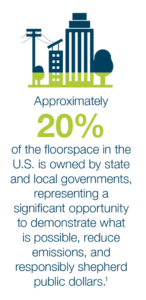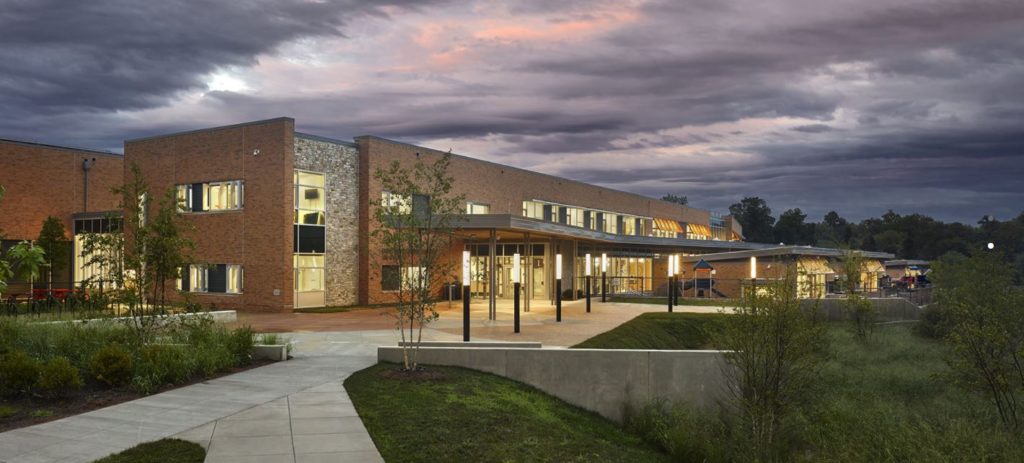With building construction and operations making up nearly 40% of U.S. carbon emissions, many jurisdictions have made reducing emissions from the built environment a top strategy for meeting climate action goals. The new Model Government Zero Emissions Buildings Policy released today helps with plug-and-play policy language for jurisdictions taking a “Lead by Example” approach to building decarbonization.
This new tool aims to help accelerate construction and operation of zero emissions buildings—both for carbon and other greenhouse gases (GHG) — by providing sample language that can be adapted to meet each jurisdiction’s needs. It includes sample policy language ready for incorporation into legislation, executive orders, procurement guidelines, or other policies that guide the construction and operation of government buildings. The model language was developed with input from several cities participating in the American Cities Climate Challenge and the Natural Resources Defense Council (NRDC).
Challenge and the Natural Resources Defense Council (NRDC).
“Having well-researched, well-vetted model policy language makes it easier for policymakers to take a critical first step in making progress toward equitable net zero emissions goals,” says Bryan M. Clark, Chief Sustainability Officer, Columbus, Ohio.
By using their own buildings to demonstrate how new technologies and operational procedures can cut both energy use and carbon emissions, governments can show the market what is possible. They demonstrate the ways in which zero emissions buildings benefit owners, tenants, and the general public—by lowering operating costs, reducing pollution, and serving as comfortable, healthy places to work, live, learn and recreate. Their procurement practices can also drive change in the local market, creating new opportunities for their suppliers, builders, and those they employ. These building professionals can share what they learn with other clients and generate more awareness of best practices—ultimately making this approach even more affordable.
Yet to date, just a handful of subnational governments have passed policies committing themselves to zero emissions in buildings. Barriers such as political will, budget constraints, and lack of expertise have held jurisdictions back from making the commitment to fully decarbonize their building stock. Encouragingly, the U.S. General Services Administration recently announced a net zero emissions policy for federally owned and operated buildings by 2045 – leadership which will inevitably pave the way for more local government action.
A future-proof building policy
In the U.S., approximately 20% of floorspace is owned by state and local governments, representing a significant opportunity to demonstrate climate leadership. Until recently, Lead by Example municipal building programs have largely focused on improving energy performance. The Model Government Zero Emissions Buildings Policy helps jurisdictions shift their focus toward achieving zero emissions in buildings. It goes beyond strategies that save kilowatt-hours (i.e. highly efficient lighting, heating, and cooling systems) to cover measures such as all-electric, efficient heating and cooling systems, onsite renewable energy, and choosing building materials with low embodied carbon. The policy language even provides a tie-in to transportation electrification through requirements for electric vehicle charging infrastructure.
“By providing governments with a sensible and policy-driven approach to mitigate climate change through publicly owned and operated buildings, we hope to help accelerate construction of zero emissions buildings—which we know is critical for keeping global temperature rise below 1.5 degrees Celsius,” says Olivia Walker, NRDC.
Lead by Example programs can take many forms: focused solely on new construction, including the operation and renovation of existing buildings, or defining procurement requirements. Aspects can even go beyond buildings to cover vehicles, employee commuting and travel, waste, water use, and other sectors. In all cases, adoption of the model policy language should be considered as a component of broader Lead by Example programs and incorporated as appropriate.

Meeting governments where they are
The Model Government Zero Emissions Buildings Policy is a tool for all government bodies that own or occupy buildings—from parks agencies to ports to school districts regardless of how far along they are on climate action. It is one of the many valuable resources available to jurisdictions seeking specific ways to accelerate GHG reductions in the built environment. It can be used in conjunction with other guides and resources, such as the recently released Decarbonization Roadmap for School Building Decision Makers, which helps school districts determine cost effective strategies and approaches to achieve net zero GHG emissions across a portfolio of buildings—and learn how to leverage federal and state funding opportunities.
NBI welcomes feedback from jurisdictions using the Model Government Zero Emissions Buildings Policy. We expect to incorporate feedback into future versions of this document. To track developments for this effort and access additional resources as they are released, subscribe to NBI’s newsletter and communications from our Codes for Climate initiative.
View Model Government Zero Emissions Buildings Policy
by Erin Beddingfield, Associate Director of Codes and Policy, New Buildings Institute
Top photo: CA Lottery in Santa Fe Springs | Credit: LPAS Arch+Design
Did you enjoy this content? Consider supporting NBI’s work with a donation today.
